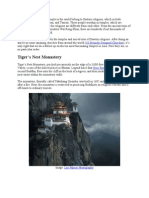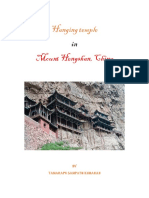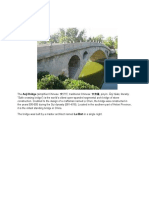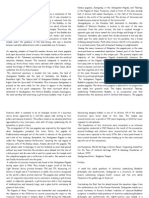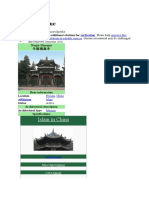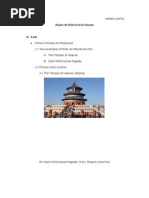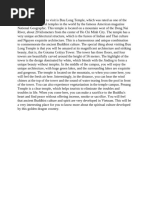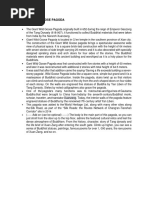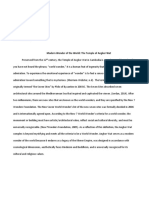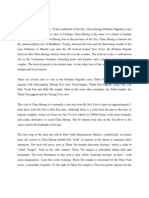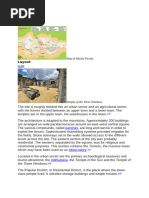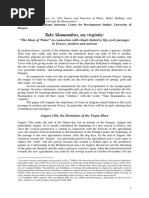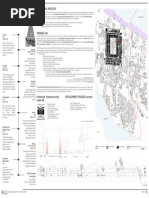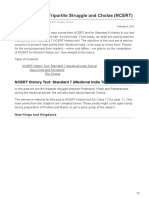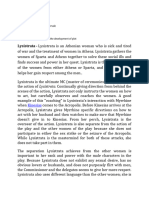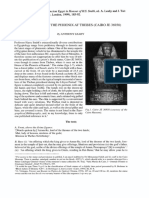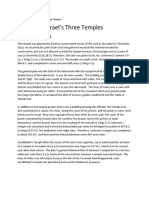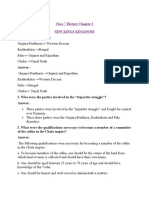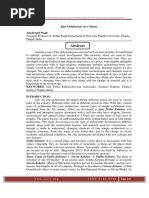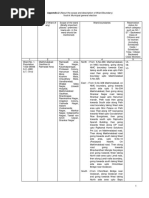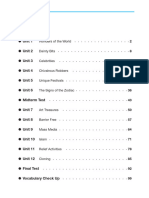0 ratings0% found this document useful (0 votes)
12 viewsChùa Huyền Không: (Xuan Kong Si)
Chùa Huyền Không: (Xuan Kong Si)
Uploaded by
Pavithra BalajiThe document summarizes the Hanging Monastery located in Shanxi Province, China. It was built over 1400 years ago on a cliff face using natural formations. Its halls, pavilions, and walkways are suspended on the cliff and connected by bridges. It has survived for centuries due to its architectural design that incorporates the rock for support. The monastery houses Buddhist, Taoist, and Confucian elements and sculptures and has become a major tourist attraction.
Copyright:
Attribution Non-Commercial (BY-NC)
Available Formats
Download as PPS, PDF, TXT or read online from Scribd
Chùa Huyền Không: (Xuan Kong Si)
Chùa Huyền Không: (Xuan Kong Si)
Uploaded by
Pavithra Balaji0 ratings0% found this document useful (0 votes)
12 views52 pagesThe document summarizes the Hanging Monastery located in Shanxi Province, China. It was built over 1400 years ago on a cliff face using natural formations. Its halls, pavilions, and walkways are suspended on the cliff and connected by bridges. It has survived for centuries due to its architectural design that incorporates the rock for support. The monastery houses Buddhist, Taoist, and Confucian elements and sculptures and has become a major tourist attraction.
Original Title
HuyenKhongTu_
Copyright
© Attribution Non-Commercial (BY-NC)
Available Formats
PPS, PDF, TXT or read online from Scribd
Share this document
Did you find this document useful?
Is this content inappropriate?
The document summarizes the Hanging Monastery located in Shanxi Province, China. It was built over 1400 years ago on a cliff face using natural formations. Its halls, pavilions, and walkways are suspended on the cliff and connected by bridges. It has survived for centuries due to its architectural design that incorporates the rock for support. The monastery houses Buddhist, Taoist, and Confucian elements and sculptures and has become a major tourist attraction.
Copyright:
Attribution Non-Commercial (BY-NC)
Available Formats
Download as PPS, PDF, TXT or read online from Scribd
Download as pps, pdf, or txt
0 ratings0% found this document useful (0 votes)
12 views52 pagesChùa Huyền Không: (Xuan Kong Si)
Chùa Huyền Không: (Xuan Kong Si)
Uploaded by
Pavithra BalajiThe document summarizes the Hanging Monastery located in Shanxi Province, China. It was built over 1400 years ago on a cliff face using natural formations. Its halls, pavilions, and walkways are suspended on the cliff and connected by bridges. It has survived for centuries due to its architectural design that incorporates the rock for support. The monastery houses Buddhist, Taoist, and Confucian elements and sculptures and has become a major tourist attraction.
Copyright:
Attribution Non-Commercial (BY-NC)
Available Formats
Download as PPS, PDF, TXT or read online from Scribd
Download as pps, pdf, or txt
You are on page 1of 52
CHÙA HUYỀN KHÔNG
(Xuan Kong Si)
Ngôi Chùa Treo
(Hanging Buddhist Monastery)
Hình ảnh lấy từ Google Earth
ĐVGiáp thực hiện
Xuan Kong Si : Hanging Chinese Buddhist Monastery
The Hanging Temple is a temple built into a sheer cliff above
Jinlong Canyon, near Mount Heng in the province of Shanxi.
Its halls and pavilions are built along the contours
of the cliff face using the natural hollows and outcrops.
The buildings are connected by corridors, bridges and boardwalks.
The closest city is Datong, 65 kilometers to the northwest.
Along with the Yungang Grottoes,
the Hanging Temple is one of the
main tourist attractions and historical
sites in the Datong area.
Built more than 1400 years ago, this temple is unique not only
for its location on a sheer precipice but also because it includes
Buddhist, Taoist, and Confucian elements.
Hanging Monastery, built in 491, has survived more than 1400 years.
The extant monastery was largely rebuilt and maintained
in the Ming Dynasty (1368-1644) and Qing Dynasty (1644-1911).
How could a building like this withstand the winds and storms of so
many years? Hanging Monastery is an architectural wonder.
A unique mechanical theory was applied to building the framework.
Crossbeams were half-inserted into the rock as the
foundation, while the rock in back became its support.
Seen from below, Hanging Monastery appears
to be a tumble-down castle in the air.
Inside, Hanging Monastery provides the
same scene as other temples.
Construction experts from countries including Britain, Germany, and
Italy,
come to see the monastery. In their words, Hanging Monastery,
The monastery and everything it symbolizes embodies a
great cultural achievement of Chinese people.
The second attraction of Hanging Monastery is that it includes Buddhism,
Taoism and Confucianism. Inside the monastery, the sculptures of Sakyamuni,
There are 40 halls and cabinets, which contain about 80 sculptures made of
copper, iron, terracotta, and stone. The features are vividly carved.
Why build a monastery like this?
Location is the first reason; building a
monastery on the cliff could shield it
from floods.
In addition, the
mountain peak
protects it from rain
and snow; and the
mountain around it
also diminishes
damage from long-
time sunshine.
The second reason is that the
builders followed a principle
in Taoism: no noises,
including those from rooster
crowing and dog baying; so
from the upper ground, all
noises drop away.
Hình ảnh lấy từ Google Earth
ĐỗVănGiáp thực hiện
This Slide Show is brought to you by NidoKidoS Group
To Receive more, send an email to
nidokidos-subscribe@yahoogroups.com
Or Join us from website at
www.GetNidoKidoS.Com
Also you can participate in our Discussion Forums at
www.NidoKidoS.Org
*Nidokidos is just sharing this file. all rights are reserved by the respective authors of this presentation.
You might also like
- Chinese PagodaDocument9 pagesChinese PagodaShiella Barroga LorenzoNo ratings yet
- Gods in The Desert Religions of The Ancient Near East PDFDocument341 pagesGods in The Desert Religions of The Ancient Near East PDFSherin100% (8)
- Huyen Khong TuDocument51 pagesHuyen Khong TuAlinaCoroian100% (1)
- Unusual Way of Place To LivingDocument2 pagesUnusual Way of Place To LivingYehezkiel AdrianNo ratings yet
- Tiger's Nest Monastery: 10 Divinely Designed ChurchesDocument37 pagesTiger's Nest Monastery: 10 Divinely Designed Churchestutankhamun786No ratings yet
- Hanging Temple in ChinaDocument9 pagesHanging Temple in ChinaTamarapu Sampath KumaranNo ratings yet
- 12 Fascinating TemplesDocument11 pages12 Fascinating TemplesDayanand MungraNo ratings yet
- Anji Bridge: Simplified Chinese Traditional Chinese Pinyin Open-Spandrel Arch Bridge Sui Dynasty Hebei ProvinceDocument22 pagesAnji Bridge: Simplified Chinese Traditional Chinese Pinyin Open-Spandrel Arch Bridge Sui Dynasty Hebei ProvincejjNo ratings yet
- Bahan Paper BulkusaDocument31 pagesBahan Paper BulkusaPipit MeyliasariNo ratings yet
- China 3Document34 pagesChina 3Bernard QuiboyNo ratings yet
- Niujie MosqueDocument13 pagesNiujie MosqueHirzan FatturahmanNo ratings yet
- AimeeDocument7 pagesAimeeAimee Luisa ÜNo ratings yet
- Angkor Wat Is A Temple MountainDocument14 pagesAngkor Wat Is A Temple MountainudayNo ratings yet
- PAGODADocument11 pagesPAGODAUday DokrasNo ratings yet
- Review - Architecture of ChinaDocument58 pagesReview - Architecture of ChinailoilocityNo ratings yet
- Bingling Temple Grottoes a Journey Through Time and ArtDocument10 pagesBingling Temple Grottoes a Journey Through Time and Artpolatjan1414No ratings yet
- Pagoda Fogong TempleDocument13 pagesPagoda Fogong TempleAeonNo ratings yet
- Brihadeshwara TEMPLEDocument24 pagesBrihadeshwara TEMPLEYaar Jigree Season 3100% (2)
- Group PresentationDocument6 pagesGroup Presentationpatrickclarin1515No ratings yet
- Architecture of ChineseDocument39 pagesArchitecture of ChineseAngelica PaguaganNo ratings yet
- BurmaDocument25 pagesBurmaShi YuNo ratings yet
- Angkor WatDocument25 pagesAngkor WatC A Muhammad Junaidh UkkashaNo ratings yet
- Top 10 Most Amazing Temples of WorldDocument12 pagesTop 10 Most Amazing Temples of WorldMushtaq M.ChinoyNo ratings yet
- Chùa Bửu LongDocument1 pageChùa Bửu Longtamto.31221022722No ratings yet
- Banteay Samre, Cambodia, Urvish DubeyDocument4 pagesBanteay Samre, Cambodia, Urvish DubeyShrey DubeyNo ratings yet
- Walls of AngkorDocument11 pagesWalls of AngkorudayNo ratings yet
- Brihadeshwara Temple - RemovedDocument17 pagesBrihadeshwara Temple - Removedkrithikamurali1404No ratings yet
- Chausath Yogini TempleDocument6 pagesChausath Yogini TempleHarshitKotiyaNo ratings yet
- Batu CavesDocument11 pagesBatu CavesTAMARAPU SAMPATHKUMARANNo ratings yet
- Wat Chalong: 1.architectureDocument3 pagesWat Chalong: 1.architecturesoufianeNo ratings yet
- WORLDWONDERDocument19 pagesWORLDWONDERGabrielle GarzonNo ratings yet
- History of Indian Architecture - by Ashish NangiaDocument177 pagesHistory of Indian Architecture - by Ashish NangiaGSus79100% (6)
- Vijayanagara Architecture WORDDocument2 pagesVijayanagara Architecture WORDShubham AgarwalNo ratings yet
- Veerabhadra Temple, LepakshiDocument10 pagesVeerabhadra Temple, LepakshiYOGITH B NAIDU YOGITH B NAIDUNo ratings yet
- Ancient India and Southeast Asia - Week 4Document14 pagesAncient India and Southeast Asia - Week 4リ0315No ratings yet
- The Temple Mountain of BaphuonDocument23 pagesThe Temple Mountain of BaphuonudayNo ratings yet
- Buddhist Architecture in Korea - Smithsonian's National Museum of Asian ArtDocument10 pagesBuddhist Architecture in Korea - Smithsonian's National Museum of Asian ArtAinun HarrisNo ratings yet
- The Spires of Angkor VatDocument75 pagesThe Spires of Angkor VatudayNo ratings yet
- SoJiwan TempleDocument5 pagesSoJiwan TempleUday DokrasNo ratings yet
- CAMBODIADocument7 pagesCAMBODIAMichelle TumamakNo ratings yet
- Giant Wild Goose Pagoda HistoryDocument1 pageGiant Wild Goose Pagoda Historygen zNo ratings yet
- Final Angkor Wat Written ReportDocument9 pagesFinal Angkor Wat Written ReportElsie NaranjoNo ratings yet
- Class Powerpoint On The Hagia Sophia by Egecan at Bilfen Schools, Istanbul, TurkeyDocument37 pagesClass Powerpoint On The Hagia Sophia by Egecan at Bilfen Schools, Istanbul, TurkeyNew7Wonders100% (2)
- Famous Buildings and Structures That Uses TimberDocument11 pagesFamous Buildings and Structures That Uses TimberDoroty CastroNo ratings yet
- WorldwonderDocument17 pagesWorldwonderGabrielle GarzonNo ratings yet
- Temples in VietnamDocument5 pagesTemples in VietnamVietnam Heritage TravelNo ratings yet
- What Are Some Unknown Facts About Brihadeeswarar TempleDocument20 pagesWhat Are Some Unknown Facts About Brihadeeswarar TempleUday DokrasNo ratings yet
- Big TempleDocument10 pagesBig Templekm_ananthNo ratings yet
- History of Korea: Widescreen PresentationDocument15 pagesHistory of Korea: Widescreen PresentationWenna Dale PasquinNo ratings yet
- CHALUKYA ARCHITECTURE ADocument35 pagesCHALUKYA ARCHITECTURE AAnkit VermaNo ratings yet
- Song Terus Museum Is One of The Karst Tourist Destination of East JavaDocument1 pageSong Terus Museum Is One of The Karst Tourist Destination of East JavamastioNo ratings yet
- Architecture: Hermitage Bulguksa Tohamsan Gyeongju South KoreaDocument3 pagesArchitecture: Hermitage Bulguksa Tohamsan Gyeongju South KoreaAnna Maria.No ratings yet
- Angkor WatDocument6 pagesAngkor WatSathishNo ratings yet
- Halls, Pavilions, and Monasteries - BuenoDocument20 pagesHalls, Pavilions, and Monasteries - BuenoPaul Clarence CondeNo ratings yet
- Layout: Map of Machu PicchuDocument3 pagesLayout: Map of Machu PicchuConstantin PollNo ratings yet
- Brihadeswar Temple Construction ReportDocument19 pagesBrihadeswar Temple Construction ReportKhagesh Kumar PalNo ratings yet
- Architectural Styles You Can Identify - Architecture Reference & Specification Book | Children's Architecture BooksFrom EverandArchitectural Styles You Can Identify - Architecture Reference & Specification Book | Children's Architecture BooksNo ratings yet
- Yemyems S Report On MythDocument15 pagesYemyems S Report On MythJanna AlitaoNo ratings yet
- Take Skamandros My Virginity The IdeasDocument22 pagesTake Skamandros My Virginity The IdeasJana IvanovaNo ratings yet
- ControlsDocument1 pageControlsMOHESHBABU RNo ratings yet
- AjmerDocument15 pagesAjmerDipesh ChauahanNo ratings yet
- Guruvayur HistoryDocument1 pageGuruvayur HistoryVenugopalNo ratings yet
- King Pasenadi KosalaDocument3 pagesKing Pasenadi KosalaNurliliafriyanti YantiNo ratings yet
- Kalinga Arch.Document4 pagesKalinga Arch.Anmol YaduvanshiNo ratings yet
- Significance of Gundicha Temple in Car Festival: Odisha Review July - 2013Document3 pagesSignificance of Gundicha Temple in Car Festival: Odisha Review July - 2013Aswini Kumar PaloNo ratings yet
- Madras Presidency - WikipediaDocument68 pagesMadras Presidency - WikipediaShyamal BasuNo ratings yet
- History of Architecture 3Document62 pagesHistory of Architecture 3Ronalyn Labks ÜNo ratings yet
- Medieval India Tripartite Struggle and Cholas NCERTDocument3 pagesMedieval India Tripartite Struggle and Cholas NCERTGauravNo ratings yet
- Diu List of Mosques Built by Destroying TemplesDocument1 pageDiu List of Mosques Built by Destroying Templesargentum007No ratings yet
- Hellenestic Period: (Famous Structures)Document11 pagesHellenestic Period: (Famous Structures)Darren VergaraNo ratings yet
- LYSISTRATA AristophanesDocument6 pagesLYSISTRATA AristophanesmimNo ratings yet
- Deccan QueenDocument156 pagesDeccan QueenBadr KaziNo ratings yet
- In The House of The Phoenix at Thebes (Cairo Je 36938)Document8 pagesIn The House of The Phoenix at Thebes (Cairo Je 36938)Dalinda BuenaNo ratings yet
- Grim Citadel Beta 2.0Document10 pagesGrim Citadel Beta 2.0Luca Cor100% (1)
- Israels Three TemplesDocument2 pagesIsraels Three TemplesCharity ColeNo ratings yet
- Imhotep Master of Ancient Egyptian Knowledge: Vol. Issue Number 2003Document18 pagesImhotep Master of Ancient Egyptian Knowledge: Vol. Issue Number 2003ReubenNo ratings yet
- Eseva Receipt: Executive Officer, TTDDocument1 pageEseva Receipt: Executive Officer, TTDChodhavarapu Subba LakshmiNo ratings yet
- Class 7 History Chapter 2 New Kings KingdomsDocument3 pagesClass 7 History Chapter 2 New Kings KingdomsPrincipal SSIT, G'nagarNo ratings yet
- Jain ArchitectureDocument9 pagesJain ArchitectureSuhaniNo ratings yet
- इंग्रजी परिशिष्ट-2Document51 pagesइंग्रजी परिशिष्ट-2Raj SanghviNo ratings yet
- Complete Temple Architecture PDFDocument30 pagesComplete Temple Architecture PDFselvakumararNo ratings yet
- 2022-Himalayan Calender by SagesDocument28 pages2022-Himalayan Calender by SagesRamji Rao100% (1)
- Ajmer - WikipediaDocument8 pagesAjmer - WikipediaRajshekhar ReddyNo ratings yet
- Iphis and IantheDocument2 pagesIphis and IantheAngelica AndresNo ratings yet
- The Vastu Home Harmonize Your Living Space With The Indian Feng Shui (Juliet Pegrum)Document164 pagesThe Vastu Home Harmonize Your Living Space With The Indian Feng Shui (Juliet Pegrum)Diogo MacielNo ratings yet
- Bricks Listening 4 Script and KeyDocument101 pagesBricks Listening 4 Script and KeyKYUNG WON SUNGNo ratings yet




